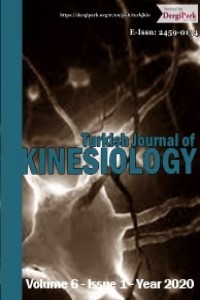Effects of interval training on the morpho-physiological parameters of hypertensive soldiers
Effects of interval training on the morpho-physiological parameters of hypertensive soldiers
Hypertensive, interval training exercise, soldier,
___
- Assadi, H., & Lepers, R. (2012). Validation of the 45 s-15 s intermittent running field test. Int J Sports Physiol Perform, 7, 277-284.
- Astrand, I., Astrand, P. O., Christensen, E. H., & Hedman, R. (1960). Intermittent muscular work. Acta Physiol Scand, 48, 448–453.
- Berthoin, S., Baquet, G., Dupont, G., & Van Praagh, E. (2006). Critical velocity during continuous and intermittent exercises in children. Eur J Appl Physiol, 98, 132-138.
- Berthoin, S., Blondel, N., Billat, V., & Gerbeaux, M. (2001). The velocity at VO2max, signification and applications to running. Staps, 54, 45-61.
- Gnakamene, J-B., Safar, M., Blacher, J. (2009). Traitementmédical de l'hypertensionartérielle, in Encyclopedie Médico-Chirurgicale (EMC). Elsevier Masson SAS: Paris.
- Isomaa, B., Almgren, P., Tuomi, T., Forsén, B., Lahti, K., Nissén, M., Taskinen, M-R., & Groop, L. (2001). Cardiovascular morbidity and mortality associated with the metabolic syndrome. Diabetes Care, 24, 683-689.
- Jordan, C. O., Slater, M., Kottke, T. E. (2008). Preventing chronic disease risk factors: Rationale and feasibility. Medicina (Kaunas), 44(10), 745-750.
- Kelley, G. A., Kelley, K. A., & Tran, Z. V. (2001). Aerobic exercise and resting blood pressure: a meta-analytic review of randomized, controlled trials. Preventive Cardiology, 4(2), 73–80.
- Kodama, S., Saito, K., Tanaka, S., Maki, M., Yachi, Y., Asumi, M., Sugawara, A., Totsuka, K., Shimano, H., Ohashi, Y., Yamada, N., Sone, H. (2009). Cardiorespiratory fitness as a quantitative predictor of all-cause mortality and cardiovascular events in healthy men and women: a meta-analysis. JAMA, 301(19), 2024-2035.
- Kokkinos, P., Faselis, C., Narayan, P., Myers, J., Nylen, E., Sui, X., Zhang, J., Lavie, C. J. (2017). Cardiorespiratory fitness and incidence of type 2 diabetes in United States veterans on statin therapy. Am J Med, 130(10), 1192-1198.
- Smith, T. P., Coombes, J. S., Geraghty, D. P. (2003). Optimizing high-intensity treadmill training using the running speed at maximal O2 uptake and the time for which this can be maintained. Eur J Appl Physiol, 89(3-4), 337–343.
- LitoBox (2017). HIIT: le guide complet (édition 2017). Retrieved 2017, from http://www.litobox.com/hiit. World Health Organization. (2013). Global status report on non-communicable: diseases. Retrieved March 15, 2013, from http://whqlibdoc.who.int/publications, _eng.pdf.
- Yayın Aralığı: 4
- Başlangıç: 2015
- Yayıncı: Nurtekin Erkmen
Fateme NİKKHOO AMİRİ, Mohammadbagher FORGHANİ OZRUDİ
Development of explosive power in basketball players
Nikola AKSOVIĆ, Bojan BJELİCA, Filip MİLANOVİĆ, Ljubica MİLANOVİC, Nemanja JOVANOVİĆ
Effects of interval training on the morpho-physiological parameters of hypertensive soldiers
Kiana NGASA, Godefroid KUSUAYİ, Mundu GUSTAVE, Nsinga CLAUDE, Mbala CELESTIN, Ngomo MONIQUE, Constant NKIAMA, Kape KALUMBE, Kabanda GİLBERT, Katosia Lusenge WİLLY
Barriers to physical activity in adolescents: A systematic review
Milan ZELENOVİĆ, Mila MANİĆ, Aleksandar STAMENKOVİĆ, Ilma ČAPRİĆ, Danijel BOŽİĆ
Motor-functional profile of footballers of junior and cadet age
Milan ANĐELIĆ, Goran VASIĆ, Siniša KARIŠIK, Kosta GORANOVIĆ, Branislav RAJIĆ, Marko JOKSIMOVIC
